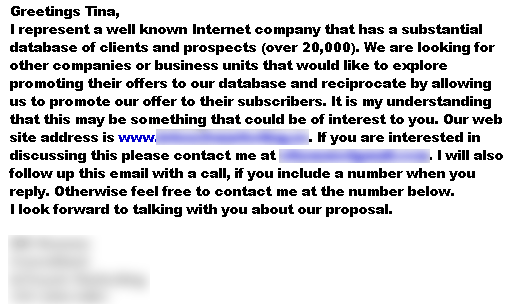15 Tips for Writing Effective Email
 Photo by
Lucia Holm
Photo by
Lucia Holm
Have you ever needed to email someone – a stranger, asking them for a favor? How can one compose email such that they will be read and responded to? How do we effectively email someone who gets a lot of email?
Whether personal or business, the ability to compose efficient and effective email is super useful – both in terms of productivity and responsiveness.
We’re all busy, and we’ve all received long, ambiguous and rambling email. Ironically, most of us have also been guilty of writing such verbose email while requesting for someone else’s time.
Now that I’ve had a little taste, on the receiving end of such email, it quickly became obvious which kind of email works and which do not. I have made some interesting and useful observations on effective email – particularly,
- What not to do when emailing someone (ie. a stranger).
- How to write email that people will actually (want to) read.
The point of this article is to share tips on how to approach people via email in the most efficient way possible, along with some common pitfalls on why some emails do not work.
Assumptions
Before we dive in, let’s lay out some assumptions:
- The recipient (person you are emailing) potentially gets a lot of email
- You need something from the recipient and plan on pitching it via email
- You either do not know the recipient, or she is an acquaintance, or she is a close friend and you’re asking for an unusual request.
Our goal is to construct email that:
- Will actually be read
- Will actually be understood
- Will not annoy the receiver
- Does not take up too much time on the receiver’s end.
Email Psychology
Generally speaking, the sender and receiver see things from drastically different points of views. And from the perspective of a sender, we often do not spend time understanding who the receiver is and what their inbox might look like. Let’s have a quick glance at both sides:
Observing the Receiver
- Gets a lot of email.
- May receive compliments regularly, if they are a public figure.
- Regularly gets asked a standard set of questions and favors.
- Does not have a lot of free time.
- Does not mind helping you, if it is fast.
Observing the Sender
- Spends a long time crafting the ‘perfect’ (-ly long) email.
- Believes that their request is original, unique, and special.
- Believes that they are the first to ask for such favors.
- Cannot imagine why anyone would turn them away.
- Desires to tell the whole story, explained from every angle, so that the listener can understand their point of view.
With such divergent perspectives, it’s no wonder receivers receive the kinds of email that they do, and that senders are wondering why their emails isn’t effective or eagerly responded to.
Now, putting ourselves in the perspective of a receiver (and we’ve all been there). When we are faced with going through an inbox full of email – coming back from a vacation for example, we have some natural habits that are worth noting:
- We tend to answer, or be drawn to email that are the fastest to answer or process. That means email that require very little work or thought.
- When we open an email that’s very long, our gut reaction is to close the email, or come back to it later when we might have more time.
- When we receive an email from someone wanting something from us, wanting us to buy something, or wanting our time, we instantly feel guarded and will automatically want to say no, even if the offer will benefit us in reality.
- We go through email while asking “what’s the point?”
- We go through email that is pitching something while asking “why should I care?”
15 Tips for Composing Clear, Concise & Responsive Emails

1. Determine Your Desired Outcome
Most people know roughly what they want, but do not take the time to clearly think it through. This is how we end up with ambiguous or rambling email. Without a clear understanding of our desired end results, our thoughts are disorganized and we can easily confuse the receiver.
There are 4 types of email:
- Self Fulfilling Email – The email itself is the point. You want to tell the receiver something, either a compliment or information. No reply is necessary.
- Inquiries – You need something from the receiver in the form of a reply. For example, advice, or questions answered. The reply is your desired outcome.
- Open-Ended Dialog – to keep communication lines open, for the purpose of some future result or benefit.
- Action Emails – The goal is not the reply, but some action on the part of the receiver. For example, a sales pitch, or asking for a website link exchange.
Which type of email are you sending? What is your desired outcome?
The clearer your intention, the more focused you will be, the better you can cater email for the intended result, the more likely you will get your desired outcome.
2. Quickly Answers, “What’s the Point?”
People want to know “what do you need from me?” Answer this question quickly. Skip long introductions, backgrounds, compliments and details. Jump to the point. State it clearly using minimal words.
If action is needed, make it clear what the desired action is from the recipient.
And if no action or reply is expected, say that! “No reply necessary.” It’ll be like music to their ears.
3. State Benefits Clearly
If a pitch is presented, make sure it includes many clearly stated, easily understood benefits for the receiver.
Too many pitchy emails focus solely on the sender and why the action will benefit the sender. If you don’t present incentives, or they are difficult to understand, the receiver will say no – resulting in a waste of time for both.
Also, make sure the incentives are realistic, the exchange is fair, and there truly are benefits to the receiver. Do your homework before contacting someone. Put yourself in their shoes, “Would you act on the offer?”
Example, emailing a high profile website like lifehacker for a link exchange is not a fair exchange. It’s called spam. If they don’t display links to other sites, likely they won’t display yours.
4. Remember to KISS
KISS = Keep it simple, stupid (I didn’t come up with this)
When we send out a long email asking for something from the receiver (time, favor, etc), we are essentially saying “I do not respect your time.” Show them you appreciate their time, by making email short, and simple to answer.
Using as few words as possible, introduce who you are, context if necessary, and why you are emailing.
Being brief doesn’t mean we have to be boring. We can be creative with our wording, add a dash of personality where you see fit, but still be brief.
5. Save the Whole Story – Stick to the Facts.
People tend to say too much in email. We feel compelled to describe all the details and disclose the whole of our existence so that the receiver can understand the whole picture. Truth is, unless you already know this person well, they really don’t care.
Unless asked, you don’t need to overly elaborate anything. Simply stick to the facts – it’ll help you keep your message short.
6. Pretend Face-to-face Intro
If you just met someone new at a party, would you open your mouth first and give them a rambling story about your life? Probably not. Typically, we close our mouth after a quick intro. In email, stopping talking is equivalent to hitting the send button.
Treating email introductions as if you are meeting them in person is another trick to keeping messages short.
7. Text Message Trick
When we are on mobile devices like the blackberry or our cell phones, we lack the fluidity of the computer keyboard, and as such, we get to the point really fast.
Now, pretend you’re on a mobile device, what would your message be now?
8. Avoid Excessive Compliments
Some people have the idea that the more compliments they throw out, the more likely the receiver will comply with their offer/need/pitch.
There is a difference between being genuine and saying what’s on your heart, and going out of your way to compliment someone. We humans are exceptional at detecting unauthentic phrasings and remarks – even in email.
Compliment only if you really mean it. And remember to be brief if you need action from the receiver.
9. Be Personal and Personable
Personalize email with relevant remarks to the receiver, put in a quick comment about their site, product or work. Address the person by name, sign email with your own name, and a friendly comment like “Enjoy your weekend!”
10. Make it Easy to Be Found
In your signature, include appropriate URLs for your website, blog, portfolio or product. Make sure the links are functional so they can read more about you in one-click.
11. Use Simple English
When the writing is too formal or uses irrelevant technical lingo, it is difficult for laymen to understand. Plus, you come off sounding like a legal document or spammer. Neither is good.
Write like you talk, using conversational English. Be authentic and realistic.
Trying to sound professional will come off as if you are trying to sound professional. Use your real voice – it’s more endearing and approachable.
12. Font Matters
There is nothing worse than opening an email and become blinded by the brightness elicited by all the words displaying in bold. It makes me want to instantly close the email for the sake of protecting my eyes.
Alternatively, fonts that are too small, too large, or otherwise hard to read (ie. 8 point, times roman font, all bold.) makes us not want to read the email as well.
Beware of your fonts in your ‘presentation’. Do not bold the entire email, use easy to read fonts (ie. Arial), and use a standard size. Do not use extravagant colors since they don’t work well on all monitors and can be hard to read.
13. Formatting Matters
Make emails easy to read and quick to scan by using bullet points, numbered lists, and keeping paragraphs short. Highlight keywords (bold or italic) for emphasis, without overdoing it.
14. Minimize Questions
Ask questions that matter, and limit the number of questions and favors you ask in an email (one or two max). The more questions (especially open-ended ones) asked in one sitting, the less likely you are to get a response, and the less likely all your questions will be answered.
Also, ask specific questions instead of a general open-ended ones. Be reasonable and thoughtful when asking. Don’t expect the recipient to solve all our life problems. For example, “How can I get rich quick? How can I become successful?” are too broad. Break them down into specifics and ask the one question that really matters.
You can send additional questions in separate emails. Key is in keeping the line of communication open by not overwhelming the receiver.
15. Trimming of Words
Like grooming a garden, read through the finished email and trim out words, sentences, and paragraphs that do not contribute towards your desired result.
Check for potential ambiguities and unclear thinking. Can you rephrase sentences for clarity using fewer words? Check for excess commentary that doesn’t add to the email’s main point. Remove extra details disclosed, unnecessarily.
Case Study:
This morning, I received this little gem in my inbox (bold and everything):
Subject: We Are Looking For Offers For Our Database

My first instinctive reaction was “What the *bleep*?” I actually stopped reading the moment the email flashed open, because my eyes hurt from the brightness of the bold fonts. My follow up questions were: What do you need from me? What the heck are you selling? Why should I care?
After reading it about five times, I’m still left confused as to what they do, or what action items I can take – aside from giving up my phone number (which I would never do).
Reviewing our 15 tips above, a more effective email might be:
Subject: Opportunity for Free Traffic
Hi Tina,
I’m writing on behalf of <web-url>. We make it easy for bloggers to network with one another.
Our site gets X monthly page views, just having your website listed in our network will expose it to many new readers.
Here are some websites currently in our community: <list of related and well known websites>.
Joining takes less than 5 minutes and you’ll love the results: <web-url>Let me know if you have any questions.
<name>
<company name>
<site url>
Take Home Points:
- No rambling stories or long intros.
- Get to the point quickly.
- Next action clearly stated.
- Present benefits.
- Fonts and formatting matter.
- Review for conciseness, simplicity and clarity.
- One question per email.
- Be yourself – that is, the concise version of yourself.
* What types of email annoy you, as a receiver? What tips do you have for keeping email efficient? Got ideas for writing ‘pitch’ emails? Share your thoughts and ideas in the comment section. See you there!













Diane,
First, I’m really glad to see you take the bold step and reach out as a business owner and comment about such a crucial tool as email. I really liked your comments and the points you extended. I think we all get caught up in the email slave war and expend allot of effort to not only manage our daily tasks, but the onslaught of emails the sometimes intrude in our inbox. I think you are spot on and appreciate the tactful reminders to help exercise good habits. What’s next?
Cheers,
Randy
These are all great tips. Thank you!
I would like to add another favorite of mine: making it perfectly clear in the subject of the email what it is really about. “I need your help” is not nearly as effective as “Could you email me the link to the dancing babies video?”.
Try an Emailogic course – it will put you back in control of your email in 90 minutes. They do elearning which is great!
Very useful post, email is the integral part of our lives and I feel that after reading this post I could able to communicate better via emails.
When I write an email I try to keep it to a few lines, if at all possible. Bullet points help, but if the whole email is more than one page I don’t like it. ;) Great tips you have here!
Thanks for the post! I improved my own email writing with it and used it to improve the emails of my team as well.
It was a nice article. Easy to read and quick to understand
Great blog post! And to tell you already started working on using these tips for my emails..
Good tips and a well written article. We recommend that you try and make the title of the email as descriptive as possible, so you convey the contents before the reader opens the email. If you require action then use a tag in the email title that tells the reader they need to respond. We run email etiquette courses and teach people to use this tag in the title [A]. More information can be found here for those interested:
Hi Tina,
Me being in marketing dept have to be very crisp in emails to propose new offers to have joint promotions. the above article was a great help for me.
Thanks
Thanks for the post. It was quite useful to me.
I will like to add tha limiting the number of words per line
also improves the readability of email. Also justifying
it and spacing out the lines improves readability.
Thanks
Hi Tina,
This is the first article I ‘ve ever read about emailing etiquettes. Thanks for sharing this wonderful article. Great job.
Regards
Mohanan
thank you so much…the article is of great help and this what i needed most at this particular moment
Interesting article! Emailing has made correspondence less of an art form, more of a functional thing. That ultimately will have a negative effect on use of vocabulary, the richness and diversity of language, as well as on communication in general.
Brevity may be desirable at times, but it can also come across as terse or blunt or even demanding…which is very off-putting to the recipient.
As for complimenting the recipient – I think our society values cynicism to the extreme, so that expressing appreciation or gratitude is nigh impossible. How sad it is that a compliment is often seen as offensive and is mistrusted, and has to be almost apologized for!
Hey guys
Can u people let me know some tips to write the effective mails in official matters. like writing the mails to manager , clients , hr people etc.
Hi Tina
I would like request something from you, that I am somewhat hesitant when comes to e mails hence if possible can I have some examples of professional e mails.
Best regards
Tharanga
Hi Tina,
Wonderful read and thanks for the emailing tips.